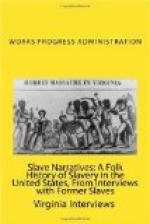“I never saw any slave houses. I wasn’t a slave. I have been to the place where my mother was raised. I was teaching school near there and just wanted to see. After her master died, Sam McCallister, his cousin, took the slave children and was their guardian. Years later it come up in court and they took all his land. Bill Mitchell was her first master. He died during slave time. McCallister was made administrator of the estate. He was made guardian of all the children too. He was made guardian of the white children and of the colored children. He raised them all. There was Ma and her auntie and three or four children of her auntie’s. Later on, way after the war, there was a lawsuit. I was grown then. The courts made him pay the white children their share as far as he was able. Of course, the colored children got nothing because they were slaves when he took them.
“I don’t know nothing about the Ku Klux Klan bothering my family. I don’t remember anything except that I hear them talking about the Ku Klux and the Pateroles. I wasn’t here.
“Don’t put me down as an ex-slave. I am not an ex-slave. I was born after the war. I don’t know nothing about slavery except what I heard others say. I expect I have talked too much anyway.”
Extra Comment
The constant reiteration of the phrase, “I’m not an ex-slave” roused my curiosity and drove me to a superficial investigation. Persons who are acquainted with her and her family estimate that Mary Watson is nearer eighty than seventy. She started her story pleasantly enough. But when she got the obsession that she would be put down as an ex-slave, she refused to tell more.
There is one thing not to be overlooked. Mary Watson has a mind that is still keen. She tells what she wants to tell, and she doesn’t state a thing that she does not want to state. The hidden facts are to be discerned only by subtle inference. This trait interested me, for her younger brother, mentioned in the story, is a distinguished character, President of Rust College, Holly Springs, Mississippi, and known to be experienced and efficient in his work. Whatever she may have reserved or stated, in reading her story, we are reading at least a sidelight on a family of which some of the members have done some fine work within the race.
Interviewer: Miss Irene Robertson
Person interviewed: Bart Wayne, Helena, Arkansas
Age: 72
“I was born at Holly Springs in 1866. It was in the springtime. Ma said I was born two years after the surrender. Ma was named Mary and pa Dan—Dan Wayne. They never was sold. In 1912 Dr. Leard was living in a big fine house at Sardia, Mississippi. He was our last owner. Mallard Jones owned them too. Pa didn’t have no name. He was called for his owners. I don’t know if he named hisself Dan Wayne or not. The way I think it was, Mr. Jones give Dr. Leard’s wife them. He give her a big plantation. I knowed Dr. Leard my own self all my life. I’d go to see him.




